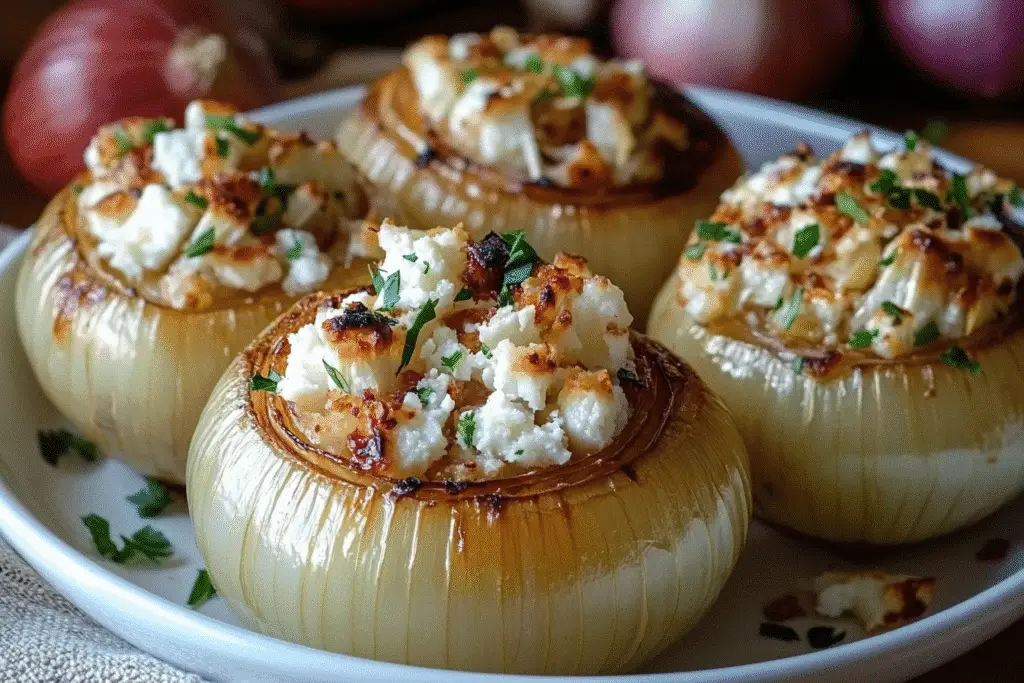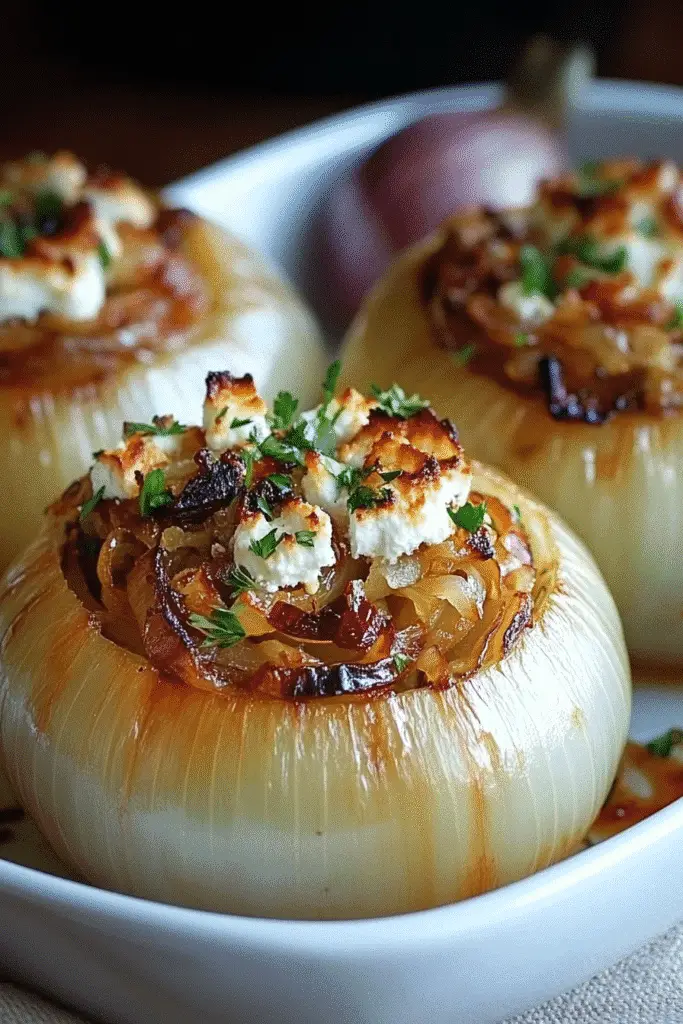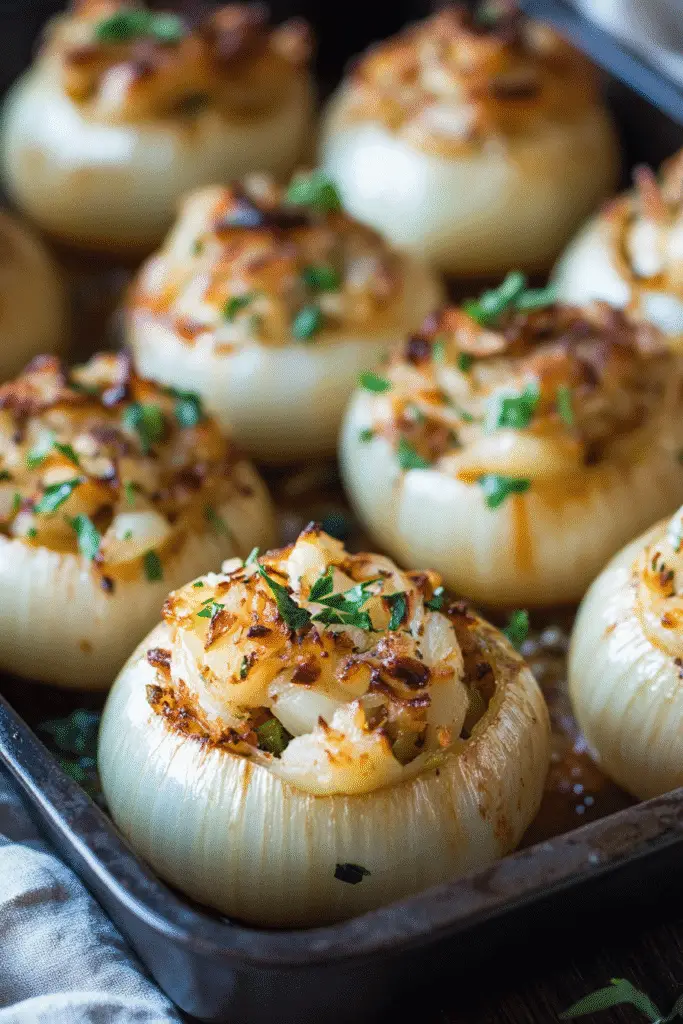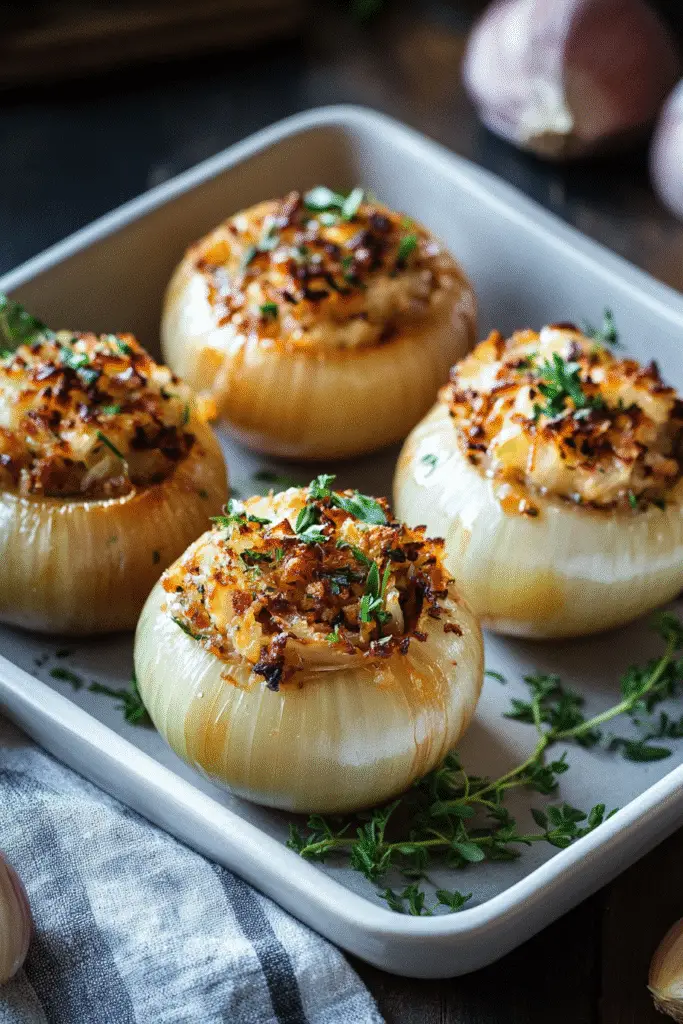When I first tasted dolmades kremmidia in a small seaside taverna in Nafplio, the dish felt like a gentle handshake from history. The onions were sweet and tender, their layers wrapped protectively around a herby rice filling that hinted of lemon groves and the sea breeze.
My Greek friend Eleni told me these stuffed onions were her grandmother’s way of stretching a little rice and meat to feed a tableful of cousins. It reminded me so much of my mamá’s kitchen in Texas — humble ingredients elevated by patience and love.

Now, I make them for my own family, a mix of Greek tradition and my own global kitchen sensibilities, and they’ve become our slow Sunday favorite when we want something comforting but light.
What are Greek Stuffed Onions?
In Greece, these are known as dolmades kremmidia — part of the dolma family, where vegetables are stuffed with rice, herbs, and sometimes ground meat. Instead of grape leaves or peppers, we use softened onion layers to wrap the filling. The onion becomes almost translucent, sweetening as it cooks and absorbing the lemony olive oil broth.
Why You’ll Love These Greek Stuffed Onions
- Light yet satisfying — perfect for warm or cool weather.
- Naturally gluten-free and easily made vegetarian.
- Make-ahead friendly — flavors deepen overnight.
- A centerpiece dish that feels both rustic and elegant.
Tips for Making the Best Greek Stuffed Onions
- Choose large onions. They’re easier to peel into big layers for rolling.
- Boil, don’t roast. Simmering makes layers flexible without falling apart.
- Pack them snugly. This keeps them from unraveling as they cook.
- Use fresh herbs. Dill, parsley, and mint bring that classic Greek brightness.
Tools You’ll Need
- Large pot for boiling onions
- Medium skillet for preparing filling
- Slotted spoon
- Sharp knife
- Cutting board
- Oven-safe baking dish or Dutch oven
- Measuring cups and spoons

How to Make Greek Stuffed Onions (Dolmades Kremmidia)
Ingredients
- 6 large yellow or white onions
- 2 tablespoons olive oil (plus more for drizzling)
- 1 small onion, finely chopped
- 2 cloves garlic, minced
- 1 cup medium-grain rice
- 1 ½ cups vegetable or chicken broth (plus extra for cooking)
- 2 tablespoons tomato paste
- 2 tablespoons chopped fresh dill
- 2 tablespoons chopped fresh parsley
- 1 tablespoon chopped fresh mint
- ½ teaspoon ground cinnamon (optional, for depth)
- Juice of 2 lemons (divided)
- ½ teaspoon salt
- ¼ teaspoon black pepper
- Optional: ½ pound ground beef or lamb for a non-vegetarian version
Step-by-Step Instructions
- Prepare the onions – Trim the root end slightly (keeping layers intact), peel, and simmer whole onions in boiling water for 10–12 minutes until outer layers are pliable. Drain and cool. Separate into large layers.
- Make the filling – In a skillet, heat olive oil over medium heat. Sauté chopped onion until soft, add garlic, then stir in rice. Add tomato paste, herbs, cinnamon (if using), and half the lemon juice. Pour in 1 ½ cups broth, simmer until rice is half-cooked (about 7 minutes). Remove from heat.
- Stuff and roll – Place a spoonful of filling on each onion layer, fold in sides, and roll gently.
- Arrange in pot – Place rolls seam-side down in a Dutch oven or baking dish, snugly packed. Drizzle with olive oil, remaining lemon juice, and enough broth to almost cover.
- Cook – Cover and bake at 350°F (175°C) for 40–50 minutes, until rice is tender and onions are soft.
- Serve – Spoon some of the cooking liquid over the dolmas before serving, and garnish with extra dill or parsley.
You Must Know
- Onion layers naturally sweeten the dish as they cook.
- Adding cinnamon gives a subtle, warm note found in some island recipes.
- These are delicious warm or at room temperature.
Top Tips for Perfecting Your Greek Stuffed Onions
- Add pine nuts or currants for a classic Greek twist.
- Use vegetable broth for a fully vegetarian version.
- Let them rest 15 minutes before serving so flavors settle.

Storing and Reheating Tips
- Store – Refrigerate in a covered dish for up to 4 days.
- Freeze – Wrap tightly in foil and store for up to 2 months.
- Reheat – Warm gently in the oven with a splash of broth to keep moist.
Helpful Notes
- Large onions yield bigger, easier-to-fill wrappers.
- The half-cooked rice will finish perfectly during baking.
- Snug packing is key to maintaining shape.
Tips from Well-Known Chefs
- Diane Kochilas recommends a generous drizzle of fruity Greek olive oil before baking for aroma and sheen.
- Michael Psilakis suggests balancing lemon juice with a pinch of sugar if your onions are very sharp.
Common Mistakes to Avoid
- Overcooking onions at the start – They’ll tear during stuffing.
- Under-seasoning the filling – Herbs and salt are vital for flavor.
- Adding too much broth – Rolls should steam gently, not boil.
FAQs
What are Greek stuffed onions called?
Dolmades kremmidia — part of the stuffed vegetable tradition in Greece.
What is a Greek stuffed vegetable called?
Gemistá, meaning “stuffed,” covers peppers, tomatoes, zucchini, and onions.
What is the Greek tradition of onions?
Onions are a staple in Greek cooking, eaten raw, baked, and in stews, valued for both flavor and history.
How to make stuffed onion dolma?
Boil onions, peel layers, fill with rice and herbs, roll, and bake in lemon-olive oil broth.

Conclusion
Greek Stuffed Onions are a beautiful example of how simple ingredients can transform into a dish worthy of a celebration table. Whether you serve them as a light main course or alongside grilled fish or lamb, they carry the flavor of Greek summers — bright, fresh, and deeply satisfying.
